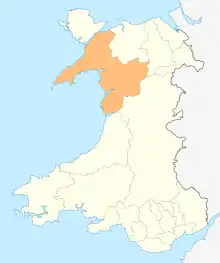Corris
Corris (occasionally called Lower Corris[1]) is a village and community in the south of Snowdonia in the Welsh county of Gwynedd. It lies in the historic county of Merionethshire/Sir Feirionnydd. Although the Snowdonia National Park covers much of the area around Corris, the village is not within the park.
| Corris | |
|---|---|
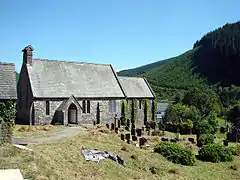 Church at Corris | |
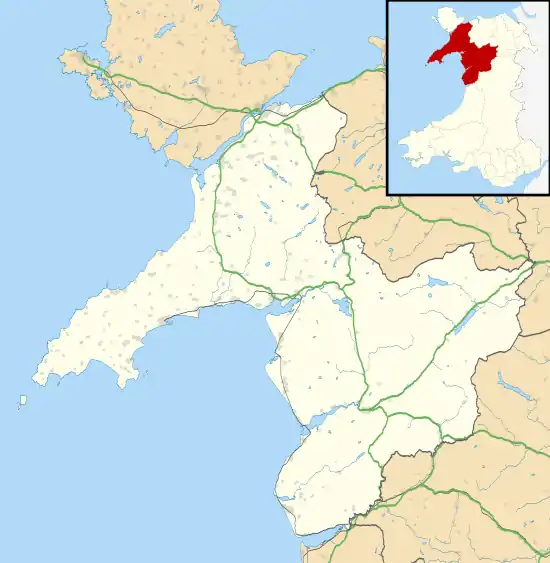 Corris Location within Gwynedd | |
| Population | 723 (2011) |
| OS grid reference | SH755078 |
| Community |
|
| Principal area | |
| Ceremonial county | |
| Country | Wales |
| Sovereign state | United Kingdom |
| Post town | MACHYNLLETH |
| Postcode district | SY20 |
| Dialling code | 0165473 |
| Police | North Wales |
| Fire | North Wales |
| Ambulance | Welsh |
| UK Parliament | |
| Senedd Cymru – Welsh Parliament | |
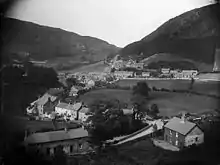

The name was first recorded in the thirteenth century and is derived from the Welsh corres ('a female dwarf'). In this context it probably means 'little one', referring to the Afon Deri river (formerly called Afon Corris), which that flows into the larger Afon Dulas at Aber Corris.[2] Thus although the area is noted for its slate mines, the name Corris has no connection with the English word quarries. Other fanciful explanations include the following by Thomas Morgan ('Afanwyson', 1850–1939): 'We find the forms Corys and Corus in the Cambrian Register for 1795. Some think the place takes its name from a saint called Corus. It is also said that Cunedda Wedig had a son called Coras. Others think that the river which gives the place its name, was called Corus from its making round excavations in the angles of its banks.'[3] The name Corris is also shared with a small river in Denbighshire, a tributary of the Clywedog that in turn flows into the River Clwyd.
The population of Corris community was 723 at the 2011 Census.[4]
Geography
Corris lies on the west bank of the river Dulas, which here forms the county boundary between Gwynedd/Merionethshire and Powys/Montgomeryshire, Powys being to the east of the river. The Afon Deri (shown on early maps as Afon Corris) runs through the village before joining the Dulas. The ancient Roman road between northern and southern Roman Wales, Sarn Helen, probably ran through the village. The settlement now known as Corris was at one time known as Abercorris (spelt Abercorys on some early maps), when the old turnpike road from Dolgellau to Machynlleth ran through the village, crossing the Dulas at Pont Abercorris. The modern A487 trunk road was built by the quarry owners in the 1840s and bypasses the village.
West of Corris, along the Deri valley is the village of Corris Uchaf (in English "Upper Corris", also known as "Top Corris").
The community also includes the hamlets of Aberllefenni further up the Dulas valley and Pantperthog to the south.
Heritage
The area is known for its natural history and for its industrial heritage. The Corris Craft Centre at Braichgoch showcases the work of local craftspeople. Several former slate mines penetrate the hillsides, and parts of what was once Braichgoch quarry can be visited on a tourist trip called "King Arthur's Labyrinth". Two miles south of Corris is the Centre for Alternative Technology.
On the bluff above the village, known as the Braich Goch, stands the Hughes Memorial. It has been described as one of the most important objects in Wales.[5]
Corris Railway Station
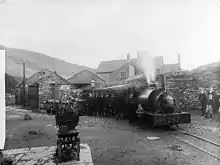
Corris railway station was a station on the former Corris Railway, a narrow gauge railway which carried slate from Aberllefenni through Machynlleth to be shipped from quays at Derwenlas and Morben on the River Dyfi. to Machynlleth. The station was open from 1883[6] until the end of passenger services, in December 1930.[7]:7 The Corris Railway Society has now restored part of the railway, from Corris to Maespoeth Junction, and passengers are carried by steam train on this section. The society has plans to extend further south in due course. Much of the abandoned route northwards to Aberllefenni and southwards to Machynlleth can still be traced.
Corris Station was unusual in British narrow gauge railways in having an overall roof covering the main line through the station, although this was removed soon after the railway closed in 1948. Although the buildings containing the carriage shed, waiting room, stationmaster's office and toilets were demolished in 1968, the adjacent railway stable block, comprising parcels office, coachhouse, harness room and hayloft, still survives and is now used as the Corris Railway Museum. North of the station the line was carried over the Afon Deri on a high stone bridge, adjacent to the similar bridge carrying the main street through the village. This bridge is still standing.
The village

Corris has a junior school, Ysgol Dyffryn Dulas, (formerly Ysgol Gynradd Corris).
Out of the many chapels in the village, only Salem remains open for worship, along with Holy Trinity Church. Corris was formerly a part of the parish of Tal-y-llyn, but until recently the church shared its vicar with Pennal.
Local government is provided by Corris Community Council, which serves the villages on the Meirionnydd side of the Dulas valley.
Another notable building in the village is the half timbered Corris Institute, built in 1911, which underwent a major refurbishment, completed in late 2006.
At the junction between the A487 and the road into the village is the Braich Goch Inn, which was originally a coaching Inn on the Londonderry Estate. It is now a bunkhouse for walkers, kayakers and mountain bikers.
Adjacent to the crossroads in the centre of the village is the Slaters Arms pub.
Corris is host to two Festivals. In February there is the Gwyl Cwrw Corris Beer Festival and September sees the Gwyl Corris Festival of Music.
Notable people
- Professor Alfred W. Hughes the first Dean of Cardiff University School of Medicine was born in Corris. The Hughes Memorial commemorates his life and works.[5]
- John Disley, Olympic medal winning athlete, was born in Corris.[8]
- Kathy Jones, Anglican priest and Dean of Bangor, was born in Corris.[9]
Further reading
Slate Quarrying at Corris, by Alun John Richards, 1994, ISBN 0863812791
References
- Stephen W. Town (15 January 1978). After the mines: changing employment opportunities in a South Wales valley. University of Wales Press. ISBN 978-0-7083-0660-4.
- Hywel Wyn Owen and Richard Morgan, Dictionary of the Place-names of Wales. Cardiff: University of Wales Press, 2007, ISBN 1-84323-901-9, p. 97.
- Thomas Morgan, The Place-names of Wales. Revised second ed., Newport: J. E. Southall, 1912, p. 12.
- "Community population 2011". Archived from the original on 1 June 2016. Retrieved 14 May 2015.
- "Welsh History Month: Corris Roadside Memorial". Wales Online. 20 May 2013.
- Boyd, James I.C. (1965). Narrow Gauge Railways in Mid Wales. The Oakwood Press. pp. 24–25.
- The Corris Railway Society (2009). "The Corris Railway – 1859 to 1948". Corris Railway – Guidebook & Stocklist. Template Printing (Nottingham) Limited.
- Peter Nichols (17 February 2017). "John Disley obituary". The Guardian.
- "'Welcome home!' for the Diocese of Bangor's new Dean". Diocese of Bangor. Church in Wales. 21 January 2016. Archived from the original on 3 February 2016. Retrieved 28 January 2016.
External links
| Wikimedia Commons has media related to Corris. |
| Preceding station | Following station | |||
|---|---|---|---|---|
| Maespoeth Junction | Corris Railway | Terminus | ||
| Historical railways | ||||
| Maespoeth Junction | Corris Railway | Garneddwen | ||
